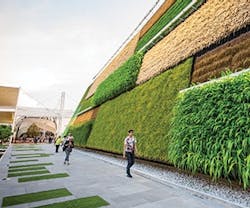Zero Waste A&D Trends: Creating a Sustainable Show
The ways in which events are becoming sustainable, sometimes to the goal of zero waste, are increasingly innovative and exciting. People in the design community are always thrilled about the materials and products out on display at the variety of A&D events that take place each year, but it’s also important to consider the materials being used to put on these shows that see hundreds, sometimes thousands of people daily.
Facility managers and event centers are stepping up to the plate with pioneering zero waste strategies that are fun for participants, profitable for facilities and most importantly, keep trash from taking up space in landfills.
“We’re in a different place than ever before, and it’s becoming a competitive advantage type of climate to save money and a desire to freshen things up and be more creative,” says Chance Thompson, SMG senior manager of sustainability and public relations at the Salt Palace Convention Center and chair of the Green Team Committee in Salt Lake City.
“It has become, ‘How can we do things smarter, different, more fun and more socially aware?’ Money always talks, especially in cases where you plan a triple bottom line approach, where you can save six figures,” he continues.
[Sipping to Sustainability: Your Ultimate Straw Guide]
Thompson points to Oracle OpenWorld as an example. The San Francisco-based tech conference stopped using disposable water bottles, saving roughly $1 million and breaking new ground in Oracle’s goal to achieve zero waste to landfill status.
Other facilities are now looking to adapt Salt Lake’s innovative strategies, Thompson explains. “Gaylord Opryland is a good example, as they are diving into sustainability pieces really strongly and have talked with us a lot about how to track waste, materials management and recycling,” he added.
When planning to attend your next interior design event, consider incorporating the strategies below as part of your sustainable preparation for before and after the show.
Zero Waste in Material Management
Trade show season does more than send attendees home with great ideas for the coming year; there’s also all of the booth swag. While that tote or t-shirt was a must-have at the show, it will likely end up in the same pile as last year’s swag. Why not repurpose it? Editor-in-chief Kadie Yale explains several ways in how one can creatively repurpose extra and unwanted show swag.
Tracy Stuckrath, founder and chief connecting officer of Thrive Meetings and Events, is also a big proponent of repurposing materials – she recalls donating 700 bags to local organizations in need at a recent event. “Planners should try to donate anything they can,” she says.
Thompson points out that for materials management, “you want to always try to donate to a 501c3 or faith-based organization.”
Zero Waste in Service Projects
As Thompson puts it, service projects within events are on the rise and a great way to incorporate sustainable initiatives at meetings and events. “Attendees have a desire to be socially impactful,” he said. For example, the 2018 AIA Conference on Architecture ended with a Community Service Day. Local firms and brands, including architecture firm MBB (Murphy Burnham & Buttrick), partnered with six non-profits throughout three boroughs in New York City to work on special projects benefiting those in need. MBB employees volunteered their time and design expertise in a partnership with Edible Schoolyard NYC, a nonprofit working with public schools to educate and empower students to make healthy food choices. Not just a way to give back, the service projects encouraged and inspired architects to connect with the city and its inhabitants.
Food supply/rescue
Along with booth swag, design events often have food and drinks left over from event catering that would otherwise go to waste. Thompson noted that Baltimore recently conducted a food rescue study to determine the best way to implement food waste rescue at its meeting venues. MGM Resorts International also has a highly sophisticated food waste program among its triple bottom line-focused initiatives. Bonus tip: try turning your day of service into a charity event that also raises money for local food pantries.
Event planners and attendees don’t have to switch to sustainable practices overnight. However, a little can go a long way if planners and the designers behind the products at the show take simple steps like recycle extra materials, prevent food waste and commit to service projects that positively impact local communities.
As Nancy Zavada, founder and president of MeetGreen, puts it: planners can have a huge environmental impact nowadays. According to Zavada, a simple step like ditching plastic is one way event planners can clean up their act.
[Read More on Zero Waste Carbon Neutral: Going Tough on Climate Change]
“Single-use plastic has become a really big issue,” Zavada said. “It’s time for planners to retool their thinking, especially when it comes to large events. Instead of recycling, ask yourself, ‘Do I really need plastic in the first place?’” she said. As a starting point, try replacing single-use plastic straws for reusable ones – you can even get them branded to pass out as booth swag.
Zavada adds that planners should utilize their supply chain. “Put your vendors on your green team by enrolling them from the start and saying, ‘We really want to make this a zero waste event. What ideas do you have to help get us there?’”
By being aware of zero waste issues and best practices for sustainability, one can start taking the first step towards change for a better event, better environment and healthier attendee.
